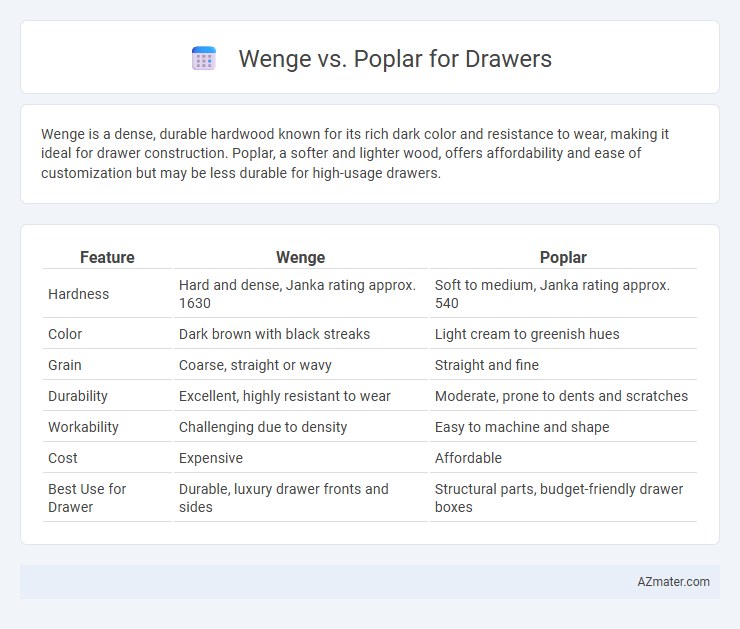Wenge is a dense, durable hardwood known for its rich dark color and resistance to wear, making it ideal for drawer construction. Poplar, a softer and lighter wood, offers affordability and ease of customization but may be less durable for high-usage drawers.
Table of Comparison
| Feature | Wenge | Poplar |
|---|---|---|
| Hardness | Hard and dense, Janka rating approx. 1630 | Soft to medium, Janka rating approx. 540 |
| Color | Dark brown with black streaks | Light cream to greenish hues |
| Grain | Coarse, straight or wavy | Straight and fine |
| Durability | Excellent, highly resistant to wear | Moderate, prone to dents and scratches |
| Workability | Challenging due to density | Easy to machine and shape |
| Cost | Expensive | Affordable |
| Best Use for Drawer | Durable, luxury drawer fronts and sides | Structural parts, budget-friendly drawer boxes |
Introduction to Wenge and Poplar Wood
Wenge wood, sourced from the African Millettia laurentii tree, is prized for its deep, rich dark brown to black coloration with subtle grain patterns, making it a luxurious choice for drawer construction. Poplar wood, derived from the fast-growing Populus species, offers a lighter, creamy white to pale yellow hue and a smooth, fine texture that facilitates easy staining and finishing. Both woods provide distinct aesthetic and functional qualities, with Wenge celebrated for its durability and exotic appearance, while Poplar is valued for its affordability and versatility in cabinetry and furniture-making.
Visual Appearance: Wenge vs Poplar
Wenge wood features a rich, deep chocolate-brown color with black streaks, creating a striking and exotic visual appeal for drawer fronts. Poplar wood displays a lighter, creamy-white to pale green hue with occasional subtle brownish streaks, providing a more neutral and versatile look. Selecting Wenge enhances a drawer's bold, luxurious aesthetic, while Poplar offers a softer, understated visual suitable for varied interior styles.
Hardness and Durability Comparison
Wenge wood boasts a Janka hardness rating of approximately 1630, significantly higher than poplar, which averages around 540, making wenge far more resistant to dents and wear. The dense grain structure of wenge contributes to superior durability and longevity in drawer construction, ideal for heavy-use environments. Poplar, while softer and less durable, offers easier workability and is often chosen for budget-friendly, light-duty drawer projects.
Workability and Ease of Machining
Wenge wood is dense and hard, making it challenging to machine and requiring sharp tools to avoid tear-out during drawer construction. Poplar offers superior workability with its softer texture, enabling easier cutting, sanding, and shaping, which reduces production time and effort for drawers. Due to Poplar's fine grain and lower density, it is more suitable for intricate joinery and smooth finishing compared to the coarse, fibrous nature of Wenge.
Cost and Availability of Wenge and Poplar
Wenge wood is significantly more expensive than poplar due to its exotic origin and slower growth rate, resulting in limited supply and higher market demand. Poplar is widely available and affordable, commonly sourced from fast-growing North American forests, making it a cost-effective choice for drawer construction. Choosing wenge offers a unique dark finish with durability, while poplar's accessibility supports budget-conscious projects without compromising workability.
Weight and Density Differences
Wenge wood, known for its high density of approximately 800-1000 kg/m3, is significantly heavier and harder compared to Poplar, which has a density around 350-450 kg/m3. This weight difference affects drawer stability and ease of use, with Wenge offering enhanced durability and a premium feel, while Poplar provides a lightweight option ideal for easily movable furniture. Choosing between these woods depends on balancing the desired sturdiness and the practical handling weight of the drawer.
Resistance to Wear and Damage
Wenge wood exhibits superior resistance to wear and damage due to its high density and hardness, making it ideal for drawers subjected to frequent use. Poplar, while softer and more prone to dents and scratches, offers moderate durability suitable for lighter, less demanding applications. Choosing Wenge ensures enhanced longevity and maintains drawer aesthetics in high-traffic areas.
Environmental Impact and Sustainability
Wenge wood, sourced primarily from Central Africa, is considered less sustainable due to overharvesting and habitat destruction concerns, whereas Poplar, a fast-growing and widely cultivated hardwood in North America, offers a more eco-friendly option with lower environmental impact. Poplar's rapid growth rate reduces deforestation pressures and supports sustainable forestry practices, making it a preferred choice for environmentally conscious drawer manufacturing. Choosing Poplar over Wenge helps minimize carbon footprint and promotes responsible resource management in woodworking projects.
Best Applications for Drawer Construction
Wenge wood offers exceptional durability and rich dark tones, making it ideal for high-end, heavy-use drawers requiring strength and aesthetic appeal. Poplar, with its lightweight nature and smooth grain, suits budget-friendly, painted drawer applications where ease of machining and stability are priorities. Choosing Wenge ensures long-lasting structural integrity, while Poplar supports versatile finishes and softer drawer interiors.
Conclusion: Choosing Between Wenge and Poplar
Wenge offers exceptional durability and a rich, dark finish ideal for luxury drawer construction, while Poplar provides a lightweight, affordable, and easy-to-paint option suited for budget-friendly projects. Consider Wenge for high-end, long-lasting furniture requiring a strong aesthetic impact, whereas Poplar is preferable for functional drawers with customization potential. The choice ultimately depends on the desired balance between cost, strength, and appearance in drawer applications.

Infographic: Wenge vs Poplar for Drawer
 azmater.com
azmater.com